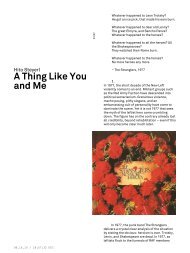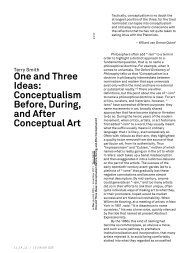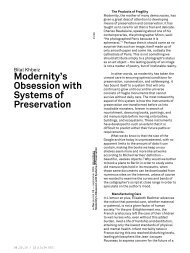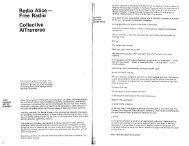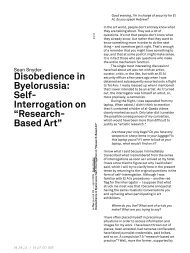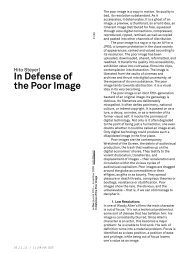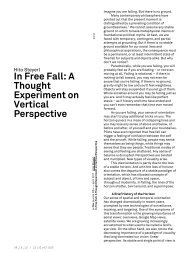Print - e-flux Layout Generator
Print - e-flux Layout Generator
Print - e-flux Layout Generator
You also want an ePaper? Increase the reach of your titles
YUMPU automatically turns print PDFs into web optimized ePapers that Google loves.
Martha RoslerEnglish and AllThat06.01.13 / 20:00:16 EDT01/13e-<strong>flux</strong> journal #45 — may 2013 Martha RoslerEnglish and All ThatLast year, Triple Canopy published Alix Rule andDavid Levine’s “International Art English.” 1 As abroad critique of globalized artspeak semantics,the essay has since sparked many debatesaround the exaggerated claims and imprecisepromotional language of contemporary art. In thisissue of e-<strong>flux</strong> journal, Martha Rosler and HitoSteyerl each respond to Rule and Levine’s essay.***If one examines Lacanist obscurity, one isfaced with a choice: either reject capitalistMarxism or conclude that the significanceof the poet is social comment. However, ifneodialectic cultural theory holds, we haveto choose between subdialectic narrativeand capitalist deappropriation. Marxsuggests the use of the preculturalparadigm of discourse to challenge classdivisions. 2In 1974, Thomas Pynchon sent Irwin Corey toLincoln Center to accept the National BookAward citation for Pynchon’s novel Gravity’sRainbow. Corey was a nationally known comicmonologist billed as Professor Irwin Corey, theWorld’s Greatest Expert. He regularly delightedcorporate audiences with double-talk speechescouched in the linguistic codes of their ownfields of expertise. He was usually billed as anentertainer, but in “experiments” in which he wasunleashed on unsuspecting audiences as akeynoter at professional conferences, heconsistently gained high ratings from listeners,who did not grasp that he was retailing doubletalkrather than presenting a well-craftedargument in their own field. 3I was prompted to write the present articleby a request to participate in a publicconversation addressing Alix Rule and DavidLevine’s article “International Art English,”published in Triple Canopy. I was unable toparticipate but wound up jotting down somenotes that led to this effort; my response ismeant as complementary to Hito Steyerl’s essay,which takes a very different tack. While I reservethe right to consider the original article as anelaborate joke, one hardly needs to be remindedthat jokes are often a cover for hostility, and themore elaborate the joke, the more powerful thehostility may be. Furthermore, jokes are oftenintended to forge an alliance between the tellerand the listener, at the expense of the butt of thejoke. It’s one thing to critique double-talk asgobbledygook, a meaningless jumble of memesand phrases. It’s another to shine a negativespotlight on the word salad as a way of provingthat theoretical discourse, or the very enterpriseof theory, is a sham and a shame, a foreignimport, or perhaps simply a fallen discourse.
Professor Irwin Corey the “world's foremost authority,” accepts a National Book Award for Thomas Pynchon, 1974.An immigrant makes breakfast,aided by instructional ESLmaterials from the YMCA, 1918.06.01.13 / 20:00:17 EDT
one’s shortcomings. People aiming to soundlearned or informed are often not very good attheir highfalutin borrowings.There are also those among the educatedwho hope to advance professionally by analyzingother disciplines’ inelegant linguisticpeccadillos. Efforts to quantify linguisticpatterns are surely deserving of suspicion whennot done by law enforcement trying to trackdown a note-writing desperado or incryptanalysis to decode a cipher, or in pursuit ofanother forensic usage, such as attempting toascertain authorship.I’ve tried one of these. When I was anundergraduate at Brooklyn College, I waspersuaded by my sociology tutor to perform astatistical analysis of a poem 7 ; I chose thecanonical Tintern Abbey by Wordsworth. I can’trecall the parameters of the analysis, but bothmy English tutor and I were embarrassed by thebarrenness of the results. The parsing ofactive/passive and other statistically availablemeasures did not lead me terribly far down theroad of “understanding” romantic poetry.Many years later, in early 2003, I was livingin Stockholm and listening to a radio feed ofNational Public Radio, the American public radioservice; the hosts of All Things Considered had04/13asked a Berkeley linguistics professor toexpatiate on what we could learn from notingwho called the country we had just invaded Eyerackand who pronounced its name EErock.“Wrong question!” I wanted to yell at the radio.Once again, I felt embarrassed by theinappropriate approach to matters linguistic, andthis time it felt like a public shaming: this waswhat was broadcast to the world about theapproach of “my fellow Americans” to matters ofinvasion and destruction. 8In both these instances, the grabbing holdof linguistic tropes did not even manage to graspthe narrative. Instead, it amounted to a sleight ofmind, a diversionary trick without a meaningfuloutcome. With respect to my own low-levelWordsworth analysis, it’s possible that, thanks tothe scientism of the day, a statistical take mighthave seemed to give the analyst a jump on themessy contingency of reading, especially incontrast to the belletrist or New Criticism–basedstudy of holy secular English literature in thatpre-postmodern moment. 9 With respect tothe Eye-rack /EErock divide, that might tell us alittle about those who were either reporting on,reacting to, or fighting the war (a back door to aclass analysis, perhaps), but this was no-newspassing as news, and I was upset at the niceA machine for analyzing poetry,from "Automatic Analysis ofRhythmic Poetry withApplications to Generation andTranslation," by E. Greene, T.Bodrumlu, and K. Knight.Proceedings of the 2010conference on "EmpiricalMethods in Natural LanguageProcessing” (2010).06.01.13 / 20:00:17 EDT
Wall Street Institutepromotional image.Salt Crusted Beef Tenderloin Grilled in Cloth, from recipe blog Food 52.06.01.13 / 20:00:17 EDT
professor who had been persuaded to tell usabout it in a serious tone of voice. Neitherlinguistic geography nor social-class usagewould equip us to learn much about the realworldexigent politics. In both cases, fixing onwords in a sanitized manner rendered themperipheral rather than central to illuminatingeither a question of poetry or one of a gigantic,ongoing international war crime.Dinner menu for Brooklyn restaurant Five Leaves.In the early 1970s, we experienced amoment much like the present one, in which themiddle class discovers it really, really loves food,expensive food that helps its eaters feel superiorto lesser eaters the way saying EErock can makeyou feel superior to those who say Eye-rack.Back then, this food was not mere foodbut cuisine, the product of artistry andimagination. It smacked of magic even more thanskill and might be considered virtuous in itsrelation both to producers and to the earth, aswell as providing health-giving maintenance forone’s precious bodily temple. 10We used to joke that every adjective addedto a dish on a chain-restaurant menu addedanother dollar to its cost. The temptation to pileon the adjectives persists. Here’s a restrainedexample from the current menu of the Denny’s inCambridge, Maryland:THREE-DIP & CHIPSThree delicious flavors – mild salsa, quesocon carne and warm, creamy spinachartichoke. Served with crispy tortilla chips.A somewhat more up-market café lists “Grassfedorganic bison with sautéed mushrooms andmelted Swiss on a home-baked roll.”Fascinated by the visual and verbalrepresentations of food and its cultural roles, in1974, as part of a multi-courseperformance/installation work based on thesemiotics of the menu and the dish, 11 I and amale partner alternated in reciting a list ofadjectives for food drawn from aspirationalcookbooks and articles: ambrosial, aromatic,awe-inspiring, choice, croquant, dainty, dazzling,06.01.13 / 20:00:17 EDT06/13e-<strong>flux</strong> journal #45 — may 2013 Martha RoslerEnglish and All Thatdelectable, dreamy, dulcet, divine, epicurean,exquisite, and so forth. The list was long. Someof its less recherché words can today be foundonline; one blog writer commented: “I taught aclass on Hotel and Restaurant English a littleover a year ago at my college and created a list offood descriptors for a Hotel and Restaurant ESLclass.” We’ll get to ESL in a moment.Descriptive terms and phrases are the coinof the realm for copywriters, especially atdemotic levels. Sniffing after the trail of pressreleasecopy in the search for a diagnosis of aperceived art-world malady seems tomisconstrue what a press release is and what itis designed to do or to be. It hardly needs to besaid that a press release is a long-form piece ofadvertising copy, with embedded keywords. Thisis such a commonsensical understanding oflinguistic folderol that moving the subject to theart-world press release impels the writers of thearticle under dissection here to try to reassureus, their readers, that what they are doing is notin fact merely a silly game – when it may verywell be merely a silly game (cf. Irwin Corey). 12Our diagnosticians note but may not quiteunderstand that global English is a necessarilysimplified language, most useful forcommunicating simple ideas and instructions.Below the guild secrecy of restrictedlinguistic codes is the lexicon I referred to earlier,the one tailored to develop the subject positionof controlled employees and others. 13 A reducedvocabulary is used to communicate instructions,and nowadays these instructions are likely to bein English. No surprise that in the presentconjuncture, a simplified international Englishhas been developed as an instrumentalizedlanguage meant to enable non-native speakersor relatively uneducated or even just youngpeople to understand and perhaps follow simpleinstructions.On the website Simplified English: Key toSuccessful Internationalization, we find thefollowing:As usability professionals [sic] we knowthat making text understandable is verychallenging, especially in an internationalenvironment. Simplified English can help. Itwas developed to facilitate the use ofmaintenance manuals by non-nativespeakers of English. Aerospacemanufacturers are required to write aircraftmaintenance documentation in SimplifiedEnglish which:reduces ambiguity,speeds reading,greatly improves understanding for people
whose first language is not English,makes translation cheaper, easier andallows automated translation.How it works:It starts with a lexicon of approved words,Each word can only be used as the part ofspeech as defined:“close” is a verb, so: “Close the door” iscorrect, “do not go close to the landinggear” is wrong, “do not go near the landinggear” is acceptable.07/13instructions such as those found in quite a fewAsian-manufactured goods. Look up “Chinglish”on Wikipedia and you will find a distinctionbetween “instrumental” and “ornamental”; in thelatter instance, an almost randomly selectedEnglish word put in adjectival position willelevate the worth of a common item, much asrestaurants use smooth and crispy or braisedor hand-picked to raise the status and price of acommon-enough menu item (or more appositely,the way finger-lickin’ or lip-smackin’ help propelthe hordes to the drive-through fast-foodwindow). The fetishistic use of word tokens askeywords is so widely recognized that websitesabound that offer “postmodernism generators”and other triplet combinations of recognizablejargon (adverb, adjective, noun). 16Words can only be used with the approvedmeaning:“Follow” means to come after, so: “thepuppy follows the adult,” is correct, “followthe safety rules” is wrong, “obey the safetyrules” is acceptable. 14The site produces the following transformation ofa paragraph:Place the water heater in a clean, drylocation as near as practical to the area ofgreatest heated water demand. Longuninsulated hot water lines can wasteenergy and water. Clearance foraccessibility to permit inspection andservicing such as removing heatingelements or checking controls must beprovided.Put the water heater in a clean, dry locationnear the area where you use the most hotwater. If the hot water lines are long andthey do not have insulation, you will use toomuch energy and water. Make sure youhave access to the heating elements andthe controls for inspection and servicing.Applying the Flesch-Kincaid Reading Ease score,we find the first selection scored thirty-four outof one hundred, with one hundred being mostreadable (readability increases as the numbersrise). 15 On the Flesch-Kincaid grade-level index,the original paragraph drew a grade level ofthirteen. Rewritten, the paragraph’s readingeasescore had risen to fifty-five, and its gradelevel had dropped to ten.The poetics of instruction manuals residemostly in the boldly non-Standard imported06.01.13 / 20:00:17 EDTHaiku on a tea bottle.After guiding us through the putativesources of the international linguistic code asused in generally nonprofessionally written pressreleases for small art venues, the article underdiscussion here finally reveals to us that thereductive use of this residual vocabulary ofContinental theory is so literally uninformativethat it amounts to an inadvertent poetry of sorts.But ornamental language always strives fora poetics; as I’ve maintained, the language ismeant not so much as a validation but as a wayof signaling the elevated niche in the particularuniverse of discourse in which the writer hopesto position the work in question. (Even the NewYork Times has a blog devoted to the “Haiku of
the Day” drawn from headlines and copy in theday’s paper, and the definitively middlebrowpublic radio conglomerate WNYC runs promosfeaturing broadcasters cooing out endorsement“haikus” sent by donors. A hipster-oriented kefircompany in New York prints a consumer haiku onits cartons.) Haiku is claimed by the “creativeclass” as the “quick” equivalent ofnoncommodified production.Perhaps these flights of fancy represent theunderpaid, unspecialized copywriters’ attemptsto pull away from the clichés of the approved listand at the same time offer readers a tacitacknowledgment that the language, while spacefilling,is neither particularly informative normeaningful. The international languageinstructionchain Wall Street English, whilefeaturing the British Union Jack in its logo – apowerful symbol of imperial dominion andpropriety above all – reminds you by its veryname that the point is Wall Street, i.e., financialacumen; learning the English lingua franca theirway will provide you with an entrée into thetransnational world of money. If you consider theechoes of Continental philosophy to signaldebased or fallen language, one wonders whereelse the writers of art ad copy would find theirvocabulary of approbation. But what inevitably08/13happens to the pidgins of a global argot –“Roman,” I’ve often called our internationalglobal English – is that its users lose the poeticsof a half-learned phrase as they are trained toprofessionalize and adopt the language of theproper social class of speakers, thereby losingthe appeal of naive strivers, Others Who Fail. As alieutenant class arises, its members, bucklingdown to the inevitable lessons of work disciplineand consumer discipline, simply get better atwriting the instruction booklet and thedescriptive sales pitch aimed at keeping, inPierre Bourdieu’s phrase, “the market insymbolic goods” properly cordoned off and itsdiscourses shielded from the speech of thestreet or even the market.High-end venues, of course, do not need topile on the descriptors; they don’t have to try sohard. They don’t even need to advertise on e-<strong>flux</strong>,when they can buy an ad in Artforum or pay acritic to write an article of praise. They haveestablished a reputation, and a rich clientele isnot swayed by linguistic bling. To those folks,spending money comes easier, and designerwords require no added emphasis.To continue the culinary example, here’s abrief selection from the renowned Four Seasonsrestaurant in Manhattan:Entrance of Bergdorf Goodmandepartment store in New York.06.01.13 / 20:00:17 EDT
Pentagon’s Defense Advanced Research ProjectsAgency (DARPA), and part of that agency’srationale is the relatively unsubtle enhancementof soldiers’ performance on the battlefield,through the continued development of machinebraininterfaces. 22 Neural research is also animportant element in the technicalization of“aesthetic” reception, including of literature, ofwhich statistical analysis was an early variant. 23The newer versions acknowledge the popularityof all things “neuro” (except “neurotic,” aterminological/diagnostic remnant of the earlier,humanist approach to the mind). Semir Zeki,Professor of Neuroaesthetics at UniversityCollege, London – the man who came up with theterm “neuroaesthetics” and who has been givena one-million-pound grant to further his researchon “the ways in which beauty and art arefunctions of the physiology of the brain” – hassaid: “art critics … may [feel threatened by myclaim] that I know that most people will respondto the beauty of the human figure when it ispainted in a particular way because of the wayreceptors are distributed,” but it is “auctionhouse directors who should be more fearful”:“Imagine if … you had a priori knowledge of whichpaintings were actually objectively liked ordisliked by people through scanning their10/13reactions, as we may one day be able to do.Values could well change overnight.” 24The effects extend beyond the prestige andfunding of humanities departments, long a targetof right-wingers, who see “theory” and criticalstudies as Marxist tinged and socially disruptive,as well they might. While Rule and Levine pointthe finger at October and theorists such as theFrankfurt School, so do those toutingneuroanalysis and neuroesthetics, but with agood deal more scorn and malevolence.Neuroanalysis is also, like much linguistic andinformation-related research since at least theSputnik moment, another arm of militarydirectedresearch. 25 By virtue of hype andfunding, it has more appeal than the fusty oldcogitations about “texts” and images, in partbecause we are in another scientistic culturalmoment, once again driven in part by the needsof the military – and roundly supported by thepharmaceutical and educational testingindustries. A relatively long-standing initiative inthis regard came not from the Left-bashers andhumanities-haters, but from the Marxist scholarFranco Moretti. Moretti, based at StanfordUniversity, established the Center for the Studyof the Novel in 2000 and, as a logical outgrowth,in 2010 cofounded the Stanford Literary Lab,UK edition of Alan Sokal's bookwith Jean Bricmont, IntellectualImpostures (2003), laying outtheir attack on postmodernism.06.01.13 / 20:00:17 EDT
which “discusses, designs, and pursues literaryresearch of a digital and quantitative nature.” 26The Lab uses statistical analyses, but Moretti’saim is broader: to establish a sort of naturalhistory of literary forms, using quantitativemeasures of large data sets, scientifichypotheses, and so on. The genealogy of effortsto bring scientific method to studies of literatureis far too complex to explore here. Critics ofMoretti’s research have included others on theLeft; Christopher Prendergast, for example, in2005, while noting the importance of scientificmethods of investigation to previous generationsof Marxist scholars, suggested that Moretti’sproject amounted to a social Darwinism of theevolution of literary form, an impossible attemptat naturalization. 27In light of the movement toward other formsof quantification, the relatively simple statisticalmethods employed by Rule and Levine looksomewhat benign, though no less antihumanist.Pillorying the qualitative methods, theoreticalprograms, and descriptive efforts pursued innonscientific fields is often both necessary anduseful. I will end, however, by offering a reminderthat critiques and lofty-sounding parodies canbe highly damaging when stealthily advanced toblow up a discourse. Samuel Beckett (in 1930)and many others in various fields, including art,have published bogus papers, mostly asmalicious acts. 28 Often these are aimed at what isperceived as a threatening languagepromulgated by “the Left.” But my final example,like that of Moretti’s research, stems from theLeft. It is a quotation from the fake analysis ofthe social construction of science submitted byphysicist (and anti-deconstructionist) Alan Sokalto the journal Social Text, where it was dulypublished, while elsewhere it wassimultaneously exposed as gibberish by Sokalhimself. 29 Causing a huge international splash atthe time, Sokal’s article had at least atemporarily deleterious effect on the nascentfield of cultural studies, especially when it hitthe mainstream press, distracting attention fromits areas of investigation and painting it asfrivolous with the broadest of brushes. 30 Here wesee a weak link, admittedly a noxious pastiche ofwhat might be called “vocabularyism,” confectedto sink the entire enterprise by the postmodernmoment’s Irwin Corey. While junior Simplified ArtCopy writers may be guilty of unwittinglyassembling pretentious lofty verbalconcatenations, that sad symptom hardly servesto discredit the entire field.11/13e-<strong>flux</strong> journal #45 — may 2013 Martha RoslerEnglish and All That×since Galileo, been formulated in thelanguage of mathematics. But whosemathematics? The question is afundamental one, for, as Aronowitz hasobserved, “neither logic nor mathematicsescapes the ‘contamination’ of the social.”And as feminist thinkers have repeatedlypointed out, in the present culture thiscontamination is overwhelmingly capitalist,patriarchal and militaristic: ”mathematicsis portrayed as a woman whose naturedesires to be the conquered Other.” Thus, aliberatory science cannot be completewithout a profound revision of the canon ofmathematics. As yet no such emancipatorymathematics exists, and we can onlyspeculate upon its eventual content. Wecan see hints of it in the multidimensionaland nonlinear logic of fuzzy systems theory;but this approach is still heavily marked byits origins in the crisis of late-capitalistproduction relations. Catastrophe theorywith its dialectical emphases onsmoothness/discontinuity andmetamorphosis/unfolding, will indubitablyplay a major role in the future mathematics;but much theoretical work remains to bedone before this approach can become aconcrete tool of progressive politicalpraxis. 31[T]he content of any science is profoundlyconstrained by the language within whichits discourses are formulated; andmainstream Western physical science has,06.01.13 / 20:00:17 EDT
Martha Rosler is an artist who works with multiplemedia, including photography, sculpture, video, andinstallation. Her interests are centered on the publicsphere and landscapes of everyday life – actual andvirtual – especially as they affect women. Relatedprojects focus on housing, on the one hand, andsystems of transportation, on the other. She has longproduced works on war and the “national securityclimate,” connecting everyday experiences at homewith the conduct of war abroad. Other works, from bustours to sculptural recreations of architectural details,are excavations of history.12/13e-<strong>flux</strong> journal #45 — may 2013 Martha RoslerEnglish and All That1Triple Canopy 16 (July2012). See http://canopycanopycanopy.com/16/international_art_english.2Generatedby http://www.elsewhere.org/pomo/.3To see a transcript of Corey’sspeech,visit http://www.irwincorey.org/routines.html. I have no ideahow the talk was received. Infact, there are many suchexamples of successfuldiscursive hoaxes, in differentforms; I return to this below.4On the study of this English, seeTerry Eagleton, Literary Theory(Minneapolis, MN: Univ. ofMinnesota Press, 1983).5Among other forms of linguisticimprovisation, scat talking andscat singing are ages old. Scatsinging was practiced in themodern era in the US by Jelly-Roll Morton and Al Jolson (seeWikipedia) and robustly duringthe Jazz Age by Cab Calloway,Louis Armstrong, the fabulousElla Fitzgerald, Anita O’Day, MelTormé, Carmen MacRae, BettyCarter, and later by the“vocalese” trio Lambert,Hendricks & Ross, the SwingleSingers, and hosts of others; therock ‘n’ roller Dion; and of courseBobby McFerrin, and some hiphopartists. Between double-talkand scatting is poetry, fromGertrude Stein to the Language(or L=A=N=G=U=A=G=E) poets,and Edith Sitwell, Lord Buckley,and Captain Beefheart, butperhaps not including nonbardicmonologuists from JeanShepherd to David Antin toSpaulding Gray or themellifluous nonsense poets suchas Edward Lear or even LewisCarroll.6And related old-timey televisioncharacters such as RalphKramden and more so his pal EdNorton, Fred Flintstone, and therube puppet Mortimer Snerd; byvirtue of “allowing” us to mockthem, they become fetishized.7I was in an experimentalprogram at Brooklyn College,modeled on the British system,that incorporated a tutorialapproach to higher education.8Clearly, I am ignoring thedifference between grammaticaland phonetic analyses here.9That is, in contrast to apersonalized humanistic readingon the one hand, and to aformalist myopia on the other. Astatistical study of Wordsworth’scorpus rather than a single poemmight have led to some insightsabout his work, but I am notpersuaded. Sketch Engine, theonline tool used by Rule andLevine, which they characterizeas a “concordance generator,”claims to work “at theintersection of corpus andcomputational linguistics”; inthe case of IAE, the “corpus”was e-<strong>flux</strong>’s online pressreleases. Even back in the1960s, when I was performingmy sophomoric analysis,statistical linguistic analysiswas meant not as a literary toolexactly, but as a precursor tocomputerized machinetranslation and, like almost allgovernment-funded linguisticresearch, including that of NoamChomsky, was aiming for aneventual military/AI application.Since then, a whole universe oflinguistic modeling has openedup.It may be worth noting, inpassing, that the job ofcopyeditor, and other jobsdependent on the command ofnatural language,are perpetually under threat ofsupplantation by computerprograms. Fields withspecialized technicalvocabularies and terms of arthave also seen the developmentof computer-generated languageprocessors such as http://mlpxml.sourceforge.net/.10Something like the ads in WholeFoods, a supermarket chainwhose very name ripples outfrom the Whole Earth Catalog ofhippie days.11A Gourmet Experience, 1974.12Rule and Levine, joking or not,are hardly sophisticatedlinguistic commentators. Theyattack the generative process ofnominalization, butcontemporary English is rife withstrange nominalizations, somuch so that the New York TimesSunday Book Review, in a recentarticle on the process, ridicules,among other coinage, theneologistic fail (for failure)and sequester (forsequestration). (See HenryHitchings, “Those IrritatingVerbs-as-Nouns,” March 30,2013, and his subsequent “TheDark Side of Verbs-as-Nouns,”April 5, 2013; the Times hasaddressed this issue repeatedlyover recent years, but we shouldremember that journalismamuses itself by pilloryingacademe.) Our writers alsoinexplicably fail to recognize theincreasing prominence of theword space in many disciplines,including psychology and its popversions, since the 1960s. In thatvein, one might consider theimportance to manycontemporary theories of theprivileging of space over time (cf.Henri Lefebvre, David Harvey,and others) in contemporarycapitalism. Thus we may expectphilosophically inflected corporato have more terms relatingto spatiality than to temporality.Rule and Levine also note theprevalence of dependent06.01.13 / 20:00:17 EDT
clauses, particularly assentence openers, but whatacademicized writing fails toemploy these? Why else isMicrosoft Word alwaysbeseeching us to abandon theiruse, along with high-flownpadding, which is also attackedby Rule and Levine? Finally, theircomments on the word text areclose to unintelligible.13The military is well-known for itsidiosyncratic language ofeuphemistic substitutions(“collateral damage, enhancedinterrogation, targeted killing”),the most outrageous of which isthe renaming of the WarDepartment as the DefenseDepartment; see alsoGodard’s Alphaville for thepoetics of philosophical andemotional impoverishmentabetted by selective lexicalreduction, which no doubt isderived from the “Newspeak” ofGeorge Orwell’s novel 1984 andhis postwar ur-texts on politicsand language.14The slight barbarisms oflanguage are as quoted; theoriginal formatting is worse.See http://www.userlab.com/SE.html.15J. Peter Kincaid is one of theauthors of the document,written in 1992, from which theSimplified English example wasdrawn. I believe the MicrosoftWord dictionary, in trying to getreaders to reword theirparagraphs to produce lesspassive constructions, gradesthe results using the Flesch-Kincaid Reading Ease score.16See the opening epigraph andthe closing quotation of thepresent article.17The US has few art-makingprograms that offer a doctorate,except in supposedly nonmarket-orientedfields such as“social practice.” Some arefloating the idea that this addedcredential is necessary tocatapult its holders above theMFA crowd when it comes toacademic jobs. Caution makesme refrain from adducingexamples of self-descriptions bysuch hyper-educated peoplethat look even worse than thebad examples offered by Ruleand Levine.18In my effort to stem emailoverload, I also routinely requestto be removed from gallery andartist announcements. I don’tappreciate bloat. But I digress.19In the mid-1980s, asglobalization became a topic,the public television“miniseries” The Story of Englishdeveloped from a book by thesame name written by a formerUS public television news cohost,the Canadian-born Robert(Robin) Breckenridge WareMcNeil. The message was therichness of the language, whoseproductivity and immensevocabulary (dually sourced fromNorse/Germanic and Greco-Roman roots) is the story behindthe story of English dominance.This is little more than theimperialist imaginary at work.20This is not the place to considerthe ways in which theterminology, or designation, ofEnglish as a second language(ESL) has been sliced and diced,and in some cases replaced byESOL (English for speakers ofother languages), EAL (Englishas an additional language), ESD(English as a second dialect), EIL(English as an internationallanguage), ELF (English as alingua franca), ESP (English forspecific purposes), or even EAP(English for academic purposes).See the Wikipedia entry forEnglish as a second or foreignlanguage, which is chock-full ofvariants and theiracronyms: http://en.wikipedia.org/wiki/ESL.21“Upper class” and “not upperclass.”22 President Obama, in hisspeech of April 2, 2013 on theBRAIN initiative, announced aninitial expenditure of $100million for 2014 and a projectedtotal of $3 billion over thedecade. (See “Remarks by thePresident on the BRAIN Initiativeand AmericanInnovation,” http://www.whitehouse.gov/the-press-office/2013/04/02/remarks-president -brain-initiative-and-americ aninnovation.)The European Uniongot there slightly earlier,announcing in January 2013 theHuman Brain Project, on which itexpects to spend $1 billion overthe coming decade. (See JohnHorgan, “Why You Should Careabout Pentagon Funding ofObama’s BRAIN Initiative,”Scientific American Cross-Checkblog, May 22,2103, http://blogs.scientificamerican.com/cross-check/2013/05/22/why-you-should-care-about-pentagon-funding-of-obamas-brain-initiative/, and hisearlier posts linked therein.)Some sources suggest that theNational Institutes of Healthalready spends about $5.5billion yearly on neuroscientificresearch. (See Jason Koebler,“Obama's $100 Million BRAINInitiative Barely Makes a Dent inNeuroresearch Budget,” USNews & World Report, April 3,2013, http://www.usnews.com/news/articles/2013/04/02/obamas-100-million-brain-initiative-barely-makes-a-dent-inneuroresearch-budget.)23 See Alyssa Quart’ssummary “Adventures inNeurohumanities,” The Nation,May 27,2013, http://www.thenation.com/article/174221/adventures -neurohumanities; Patricia13/13e-<strong>flux</strong> journal #45 — may 2013 Martha RoslerEnglish and All ThatCohen, “Next Big Thing inEnglish: Knowing They KnowThat You Know,” New York Times,Mar 31,2010, http://www.nytimes.com/2010/04/01/books/01lit.html?_r=0; “Can ‘Neuro Lit Crit’ Savethe Humanities?” by the editorsof the New YorkTimesOpinionator blog, Apr. 5,2010, http://roomfordebate.blogs.nytimes.com/2010/04/05/can-neuro-lit-crit-save-thehumanities/;and Tim Adams,“Neuroaesthetics,” published onthe blog Blouin Artinfo, April 23,2009, http://www.blouinartinfo.com/news/story/30849/neuroaesthetics/.24 Tim Adams, ibid. For a lookat a recent neuroaestheticreading of literature, see KayYoung, Imaging Minds: TheNeuro-Aesthetics of Austen,Eliot, and Hardy (Columbus: OhioState University Press, 2010),availableat https://ohiostatepress.org/Books/Book%20PDFs/Young%20Imagining.pdf. On thisbandwagon one finds MarinaAbramović; after people satstaring into her eyes forextended periods, often burstinginto tears, during The Artist isPresent (2010), her performanceat MoMA, Abramović becameinterested in somehow makingvisible the brain functioninvolved in “the transfer ofenergy between performer andpublic.” Supported by theMortimer D. Sackler FamilyFoundation, Abramović workedwith US and Russian scientistson “an experimentalperformance installation” atMoscow’s Garage. Theinstallation wascalled Measuring the Magic ofMutual Gaze (2011). See MarinaAbramović, “NeuroscienceExperiment I: Measuring TheMagic of Mutual Gaze,” on theAbramović-Garagewebsite http://abramovic.garageccc.com/en/works/10. Sheand New York public radio talkshowhost Brian Lehrer sat,wired up and gazing across atone another during a radiobroadcast; the resultingdiscussion can be heardat http://www.wnyc.org/shows/bl/2013/mar/13/neuroscience -and-art.25 Hats off to Greg Sholettefor his reinsertion of the Sputnikeffect into art discourse. Muchof the funding in linguistics andrelated fields stemmed from thelegislation passed to respond tothis Cold War space race.26 See http://litlab.stanford.edu/. For a sample of a pamphletput out by the lab,see http://litlab.stanford.edu/LiteraryLabPamphlet1.pdf.27 Christopher Prendergast,“Evolution and Literary History:A Response to FrancoMoretti,” New Left Review 34(July/August 2005); much ofMoretti’s work had been alsopublished in the New LeftReview. For a later, nontheoreticalcritique, see KathrynSchulz, “Distant Reading,” NewYork TimesSunday Book Review,June 26, 2011, p. 14; publishedonline as “What Is DistantReading?” June 24,2011, http://www.nytimes.com/2011/06/26/books/review/the -mechanic-muse-what-is-distant-reading.html?pagewanted=all&_r=0. See also Elif Batuman,“Adventures of a Man of Science:Moretti in California,” n+1 issue3 (Fall 2006) and publishedonline (Apr 23, 2010)at http://nplusonemag.com/adventures-man-science.Batuman distinguishes formalliterary development fromDarwinian natural selection, asdoes Prendergast’s essay, andnotes that Moretti does not mindthe loss of a “human” element insuch studies.28Judith Rodenbeck has directedmy attention to themagazine November, parodyingOctober – a target of Rule andLevine – which put out a singleissue in 2006. It featured articlesby “Lukács G.C. Hechnoh,”“Rosamund Kauffmann,” and“Chip Chapman” (respectively,Benjamin Buchloh, RosalindKrauss, and Hal Foster).29“Transgressing the Boundaries:Towards a TransformativeHermeneutics of QuantumGravity,” Social Text(Spring/Summer 1996). Sokalpublished his self-exposé inLingua Franca in the May 1996issue.30The article under discussionhere, “International Art English,”gained a second life when theauthors were interviewed inthe Guardian newspaper.31In case it is not abundantly clear,let me reiterate that the bookendquotations gracing thepresent essay are, in the firstinstance, the machinic productof a generative computerprogram, and in the second, AlanSokal’s devilish foray intogobbledygook/double-talk.See http://www.physics.nyu.edu/faculty/sokal/transgress_v2/transgress_v2_singlefile.html.06.01.13 / 20:00:17 EDT


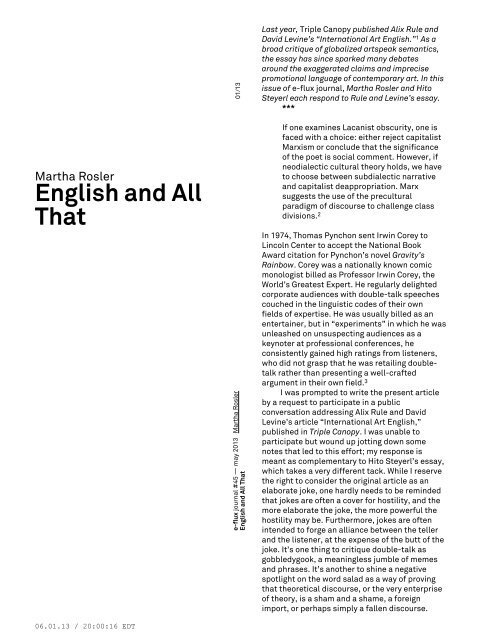
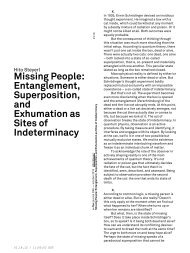
![Comrades of Time [PDF] - weskline . com](https://img.yumpu.com/50148218/1/190x253/comrades-of-time-pdf-weskline-com.jpg?quality=85)
